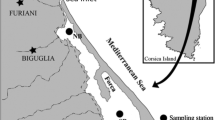Abstract
Regeneration of nutrients in aquatic ecosystems may be affected by autolysis, bacterial degradation, and activities of phagotrophic organisms. To examine the relative importance of these processes, mineralization of carbon, nitrogen, and phosphorus was studied in a two-stage continuous culture system. In the first stage (production compartment), aChlorella sp. was grown either axenically or in the presence of bacteria under P-limited conditions. In the presence of bacteria, the biomass of algae decreased due to efficient competition for P by bacteria. In the second stage (remineralization compartment), which was kept continuously in the dark, the nutrients incorporated by the organisms in the first stage were remineralized only slightly (0–25%) irrespective of the presence or absence of bacteria. However, remineralization of all nutrients tested was strongly increased (60–80%) after addition of zooflagellates, which grazed on algae and bacteria. These observations suggest that a net regeneration of nutrients was provided by phagotrophic organisms, whereas nutrients were trapped rather than released by bacteria. It is concluded that nutrient cycling could probably not proceed at the high velocities observed in the field without the participation of phagotrophic organisms.
Similar content being viewed by others
References
Alexander M (1981) Why microbial predators and parasites do not eliminate their prey and hosts. Ann Rev Microbiol 35:113–133
Bloesch J, Stadelmann P, Bührer H (1977) Primary production, mineralization and sedimentation in the euphotic zone of two Swiss lakes. Limnol Oceanogr 22:511–526
Cole JJ (1982) Interactions between bacteria and algae in aquatic ecosystems. Ann Rev Ecol Syst 13:291–314
Currie DJ, Kalff J (1984) A comparison of the abilities of freshwater algae and bacteria to acquire and retain phosphorus. Limnol Oceanogr 29:298–310
Currie DJ, Kalff J (1984) The relative importance of bacterioplankton and phytoplankton in phosphorus uptake in freshwater. Limnol Oceanogr 29:311–321
Daft MJ, McCord SB, Stewart WDP (1975) Ecological studies on algal lysing bacteria in freshwaters. Freshwater Biol 5:577–596
Eppley RW, Peterson BJ (1979) Particulate organic matter flux and planktonic new production in the deep ocean. Nature 282:677–680
Fenchel T, Jørgensen BB (1977) Detritus food chains of aquatic ecosystems: the role of bacteria. Adv Microb Ecol 1:1–49
Gunnison D, Alexander M (1975) Resistance and susceptibility of algae to decomposition by natural microbial communities. Limnol Oceanogr 20:64–70
Güde H (1984) Test for validity of different radioisotope activity measurements by microbial pure and mixed cultures. Arch Hydrobiol Beih Ergebn Limnol 19:257–266
Hargrave BT, Geen GH (1968) Phosphorus excretion by zooplankton. Limnol Oceanogr 13: 332–342
Harold FM (1966) Inorganic polyphosphates in biology: structure metabolism and function. Bact Rev 30:772–794
Johannes RE (1964) Phosphorus excretion and body size in marine animals: microzooplankton and nutrient regeneration. Science 146:923–924
Johannes RE (1968) Nutrient regeneration in lakes and oceans. Adv Microbiol of the Sea 1:203–213
King GM, Berman T (1984) Potential effects of isotopic dilution on apparent respiration in14C-heterotrophy experiments. Mar Ecol Progr Ser 19:175–180
Lampert W (1978) Release of dissolved organic carbon by grazing zooplankton. Limnol Oceanogr 23:831–834
Lean DRS, Nalewajko C (1979) Phosphorus turnover time and phosphorus demand in large and small lakes. Arch Hydrobiol Beih Ergebn Limnol 13:120–152
Maier D (1973) Eine verbesserte Methode zur Bestimmung des chemischen Sauerstoffbedarfes mit Kaliumdichromat (COD Methode) GWF, Wasser/Abwasser 114:366–370
Müller H (1972) Wachstum und Phosphatbedarf vonNitzschia actinastroides (Lemm.) v.Goor in statischer und homokontinuierlicher Kultur unter Phosphat-Limitierung. Arch Hydrobiol Suppl 38:399–484
Ohle W (1968) Chemische und mikrobiologische Aspekte des biogenen Stoffhaushaltes der Binnengewässer. Mitt Int Ver Limnol 14:122–133
Porter KG, Feig YS (1980) The use of DAPI for counting and identifying aquatic microflora. Limnol Oceanogr 25:943–948
Schmid M, Ambühl H (1965) Die Bestimmung geringster Mengen Gesamtphosphor in Wasser und Biomasse. Schweiz Z Hydrol 27:184–192
Sherr B, Sherr E (1984) Role of heterotrophic protozoa in carbon and energy flow in aquatic ecosystems. In: Klug MJ, Reddy EA (eds) Current perspectives in microbial ecology. ASM, Washington, pp. 412–423
Stöckli A (1984) The role of bacteria and algae in phosphorus regeneration using linked continuous cultures. Verh Int Ver Limnol (in press)
Stout JD (1980) The role of protozoa in nutrient cycling and energy flow. Adv Microb Ecol 4:1–34
Tilzer MM (1984) Estimation of phytoplankton loss rates from daily photosynthetic rates and observed biomass changes in Lake Constance. J Plankton Res 6:309–319
Van Es FB, Meyer-Reil LA (1983) Biomass and metabolic activity of heterotrophic marine bacteria. Adv Microb Ecol 6:111–170
Vogler P (1965) Beiträge zur Phosphatanalytik in der Limnologie II. Die Bestimmung des gelösten Orthophosphates. Fortschritte Wasserchemie Grenzgebiete 2:109–119
Williams PJ leB (1981) Incorporation of microheterotrophic processes into the classical paradigm of the planktonic food web. Kieler Meeresforsch 5:1–28
Author information
Authors and Affiliations
Rights and permissions
About this article
Cite this article
Güde, H. Influence of phagotrophic processes on the regeneration of nutrients in two-stage continuous culture systems. Microb Ecol 11, 193–204 (1985). https://doi.org/10.1007/BF02010599
Issue Date:
DOI: https://doi.org/10.1007/BF02010599




